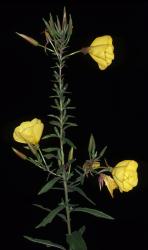- Taxon
- Gallery
- = Oenothera erythrosepala Borbás (1903)
Hairy biennial, taprooted herb. Stems to c. 1.5 m tall, branched, with dense short curly hairs, and scattered to numerous, long, dark red, bulbous-based hairs. Rosette lvs numerous, long-petiolate; petiole to 10 cm long; lamina mostly 7–25 × 2–7 cm, narrow- to broad-elliptic, sometimes ± obovate, with appressed hairs or glabrate; margins almost entire to denticulate, sinuate, ciliolate; base attenuate; apex acute. Cauline lvs, excluding uppermost, with petiole to 3 cm long and lamina usually more slender and tapering than in rosette lvs. Infl. spike often dense, simple or branched, with hairs as on stems. Fls crepuscular. Floral tube 2.5–4.5 cm long, with glandular and scattered pilose hairs, viscid, slender. Buds lanceolate, ± erect. Sepals 3.5–5 cm long, linear-lanceolate, ± reddish, with hairs as on hypanthium; apices mucronate, 5–10 mm long. Petals (3)–4–5.5 cm long, broad-obovate, bright or lemon yellow. Style exserted by 2.5–4 cm. Capsule (1.2)–1.7–2.5–(3) cm long, cylindric, widening slightly towards base, ribbed, mostly viscid but rarely eglandular. Seeds usually 1.5–2.2 mm long, often irregular, but sometimes ± oblong or lunate, sharply angled.
[From: Webb et al. (1988) Flora of New Zealand. Volume 4.]
Flowering: Dec.–Apr.




